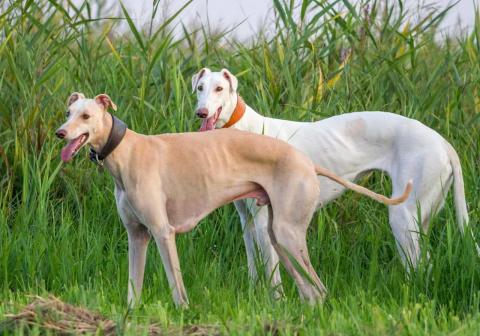
Grace and Speed: Discovering the English Greyhound
Published on April 15 by Julia
The English Greyhound is a breed renowned for its remarkable speed, graceful frame, and surprisingly calm demeanor. Originally bred for hunting and coursing game, the Greyhound has evolved into a beloved pet with a rich history and a heart as big as its stride.
Origins and History
The history of the English Greyhound dates back over 4,000 years. Ancient Egyptian murals depict similar sighthounds, but the breed as we know it was refined in Britain. Greyhounds were historically favored by royalty and nobility for their elegance and hunting prowess. In the Middle Ages, only the aristocracy could own Greyhounds, and harming one was considered a crime.
By the 19th century, Greyhounds were being bred specifically for racing, leading to the development of an industry that would eventually define their public image.

Physical Characteristics
Greyhounds are built for speed. They have long, slim bodies, deep chests, and powerful hindquarters that help them reach speeds of up to 45 mph (72 km/h). Their short, fine coats come in a wide variety of colors including black, fawn, blue, brindle, and white.
Typical height: 27–30 inches (males), 25–28 inches (females)
Weight: 60–70 pounds (males), 55–65 pounds (females)
Temperament and Personality
Despite their athletic build and racing history, English Greyhounds are surprisingly low-energy when off the track. Often referred to as “couch potatoes,” they enjoy lounging for hours. They're gentle, affectionate, and usually quiet. Their calm nature makes them great pets for families, seniors, and apartment dwellers alike.
Greyhounds are sensitive and may be shy or cautious at first. With time and patience, they become loyal companions who thrive on human companionship.
Life After Racing
Many Greyhounds are adopted as pets after retiring from the track, typically around 2–5 years of age. Organizations around the world are dedicated to rehoming ex-racing Greyhounds, giving them a second chance at a peaceful, loving life.
These retired racers often adjust well to home life, but may need time to learn basic cues or navigate household environments, as many have never seen stairs or interacted with small pets.

Care and Exercise
Despite their athleticism, Greyhounds only need moderate daily exercise—usually a couple of short walks and a chance to stretch their legs in a safe, enclosed area. Their thin coats make them sensitive to cold, so coats or sweaters are recommended in chilly weather.
Greyhounds are generally healthy, but they can be prone to bloat, dental disease, and arthritis as they age. Due to their low body fat, they may be sensitive to anesthesia and extreme temperatures.
Interesting Facts
- Greyhounds have a “double-suspension gallop,” meaning all four feet leave the ground twice during each stride.
- Their vision is exceptional—they can spot movement over half a mile away.
- Greyhounds do not typically sit like other dogs; they prefer lying down or standing.
The English Greyhound is a breed that combines elegance, history, and heart. Whether sprinting on a racetrack or curled up on your couch, this noble dog offers companionship, grace, and quiet charm. With proper care and a warm home, a Greyhound can be a truly rewarding addition to any family.